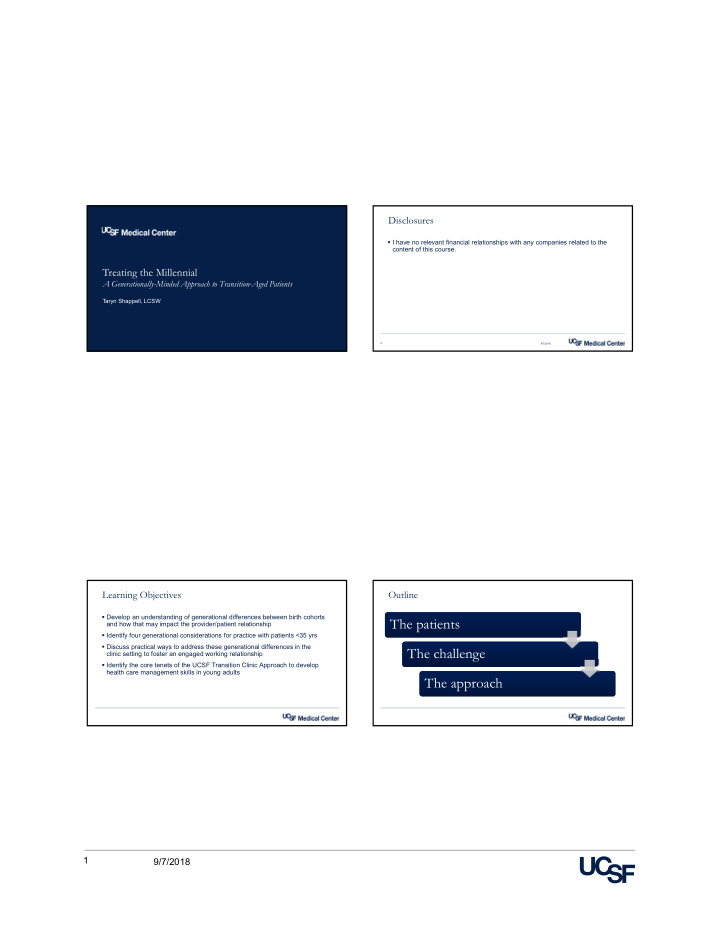



Disclosures I have no relevant financial relationships with any companies related to the content of this course. Treating the Millennial A Generationally-Minded Approach to Transition-Aged Patients Taryn Shappell, LCSW 2 9/7/2018 Learning Objectives Outline Develop an understanding of generational differences between birth cohorts The patients The patients and how that may impact the provider/patient relationship Identify four generational considerations for practice with patients <35 yrs Discuss practical ways to address these generational differences in the The challenge The challenge clinic setting to foster an engaged working relationship Identify the core tenets of the UCSF Transition Clinic Approach to develop health care management skills in young adults The approach The approach 1 9/7/2018
The Patients (why are Millennials so different ?) Dr. Jean Twenge (UCSD) 6 9/7/2018 2 9/7/2018
Our Challenges (what gets in the way?) Boomers iGen Gen X Millennials Generational Considerations Generational Considerations Technology fluency Acquired Native language TECHNOLOGY FLUENCY proficiency/fluency Information sources Locus of self-control Multiple sources, A few known, trusted INFORMATION sources trusted & not Values Self-assured and CONFIDENCE Anxious capable Individuality Time and achievement VALUES 3 9/7/2018
Generational Considerations Generational Considerations Acquired TECHNOLOGY FLUENCY Native language proficiency/fluency Multiple sources, A few known, trusted INFORMATION sources trusted & not Self-assured and Anxious CONFIDENCE capable VALUES Individuality Time and achievement 13 9/7/2018 So What Helps? Generational Considerations Acknowledge the difference Acquired Native language TECHNOLOGY FLUENCY proficiency/fluency Ask “given that I’m unable to text medical information, what is the next best way for us to communicate outside of visits?” Multiple sources, A few known, trusted Have them save your phone number as a contact during your visit INFORMATION sources trusted & not Self-assured and CONFIDENCE Anxious capable Individuality Time and achievement VALUES 15 9/7/2018 4 9/7/2018
So What Helps? Generational Considerations Assume they’ve Googled it Acquired TECHNOLOGY FLUENCY Native language proficiency/fluency Ask, “where have you looked for information on this already?” Offer reputable information resources Multiple sources, A few known, trusted INFORMATION sources trusted & not External Internal LOCUS OF SELF-CONTROL VALUES Individuality Time and achievement 17 9/7/2018 So What Helps? Generational Considerations Honest, straightforward expectation Acquired Native language TECHNOLOGY FLUENCY proficiency/fluency No assumptions or scare tactics! Empower them to use what they know to make an informed choice Multiple sources, A few known, trusted INFORMATION sources trusted & not LOCUS OF SELF-CONTROL External Internal Individuality Time and achievement VALUES 19 9/7/2018 5 9/7/2018
So What Helps? Our Approach (so what do we do? ) Affirm their uniqueness 21 9/7/2018 Our Approach Our Approach Skills-focused Skills-focused Individually-tailored • Build skills before giving responsibility DBT-informed • Concrete list of skills 6 9/7/2018
Our Approach Individually tailored • Developmentally appropriate • Considerate of knowledge & culture Our Approach DBT-informed • Support-oriented • Cognitive-based • Collaborative taryn.shappell@ucsf.edu 7 9/7/2018
Recommend
More recommend